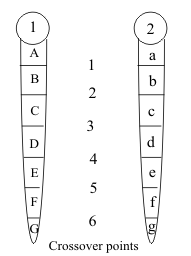
Crossing Over

1. Imagine a fly contains a pair of chromosomes as shown. The fly is heterozygous for each of seven traits, a through g, found on each chromosome.
2. In the figure, the numbers 1 through 6 indicate points where crossing over may occur, resulting in alleles being separated. For example, if a cross over occurred at point 3, the alleles on chromosome 1 would be ABCdefg, while those on chromosome 2 would be abcDEFG.
3. Roll the die to randomly determine where a cross over will occur. In the table record the alleles which would remain on the same chromosome as ‘a.’ For example, if you rolled a 4, you would record that b, c, and d remained on the chromosome with a.
4. Repeat step 3 another 99 times (Sucker!)
5. Draw a data table like the one shown (or just use the one on this page, silly)
# of times “a” is on the same chromosome as |
% of times “a” is on the same chromosome as |
b |
b |
c |
c |
d |
d |
e |
e |
f |
f |
g |
g |
6. Calculate the percentage of times each allele is found on the same chromosome as ‘a.’
Questions
1. Is the location of crossing over random or does it occur more frequently in any particular location? (random)
2. Which recessive allele most often remains on the same chromosome as “a”? (b)
3. Which recessive allele is most often separated from “a”? (g)
4. Assume a crossover occurs at point 2. What would be the resulting order of alleles on each chromosome? (ABcdefg and abCDEFG)
5. Suppose a fly containing the chromosomes in question 4 were mated with a fly recessive for all seven traits. What would be the genotypes of the offspring? (either AaBbccddeeffgg or aabbCcDdEeFfGg depending on which of the two chromosomes was inherited from the fly in Q 4.)